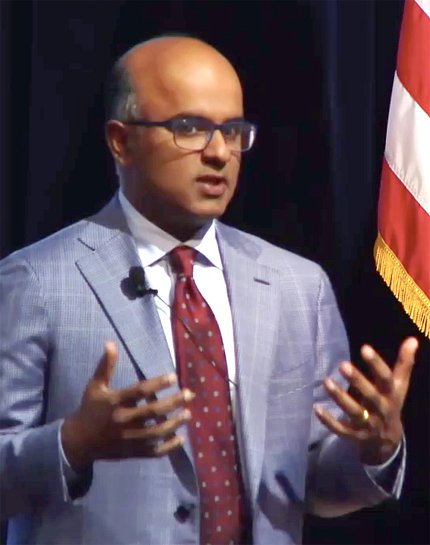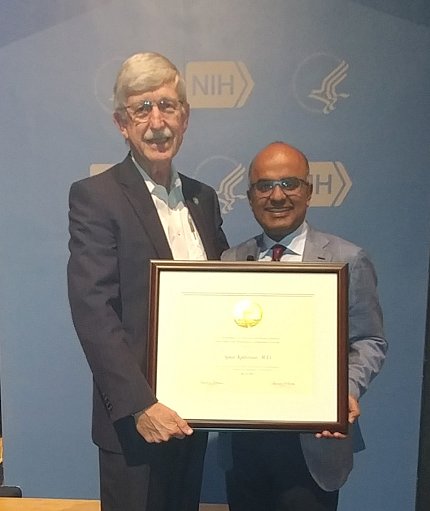‘Smoothie, Not Fruit Salad’
Role of Genes, Lifestyle Explored in Heart Attack

What if you knew you could spare yourself and your loved ones the devastation of heart attack—especially while you are still young—by paying attention to data you could have discovered at birth?
Owing largely to the massive amounts of data from large-scale genome-wide association studies funded by NIH and new population-based biorepositories such as the UK Biobank, scientists can now tease out the respective contributions of genetic predisposition and environmental exposure to the development of diseases, including heart attack.
In a Wednesday Afternoon Lecture on May 22 titled “Genes, lifestyle and risk for heart attack,” Dr. Sekar Kathiresan, director of the Center for Genomic Medicine at Massachusetts General Hospital, director of the Cardiovascular Disease Initiative at the Broad Institute and professor of medicine at Harvard Medical School—at least until he gives all these up to become CEO of a company called Verve in mid-July—described new avenues of preventing coronary artery disease, the leading global cause of mortality.
It has long been known that heart attacks run in families and that the younger the victim is, the more likely he or she drew an unfortunate inheritance. There are three main paths to one’s genetic risk of myocardial infarction (MI), said Kathiresan: the monogenic model (4 genes stand out, especially FH, among a survey of many thousands, as conferring a 2- to 5-fold risk of MI); the polygenic model (common variant association studies have linked some 95 genetic loci to coronary risk. Summed up, these can equal the predictive power of the monogenic model); and somatic mutations that arise in the body over a lifetime.
Kathiresan and his colleagues have invented a polygenic risk score that one could theoretically learn at birth as a way of navigating away, throughout a lifetime, from the reefs and shoals of heart attack risk.
Like not a few other WALS lecturers, Kathiresan credits early training at NIH as crucial to his development as a scientist. He spent the summer of 1993 here, after his first year at Harvard Medical School, and “had a terrific experience, especially with respect to becoming a physician-scientist.”
And like many other speakers, “Our science has been inspired by patients,” he said. Kathiresan summarized the case of a 42-year-old man who suffered a heart attack and died 10 days later. Ironically, only 6 months earlier, the man had seen a cardiologist who calculated the victim’s lifetime risk of MI as 1.7 percent, or “low,” using a global risk score sanctioned by the American College of Cardiology and the American Heart Association.
Confident that he could surpass that woeful predictive capability, Kathiresan and colleagues set out to determine the average risk of MI by combining insights on the genetic risk of MI, countered by the genetic basis of resistance, or protection from, MI.

MI has two phases, he said. The first is chronic—decades of plaque buildup in coronary arteries. The second is when a tear forms on the inner wall of an artery on the surface of the heart. A clot forms, stopping blood from flowing. If the blockage lasts for more than 20 minutes, necrosis sets in and heart muscle dies.
Although there are both heritable and lifestyle components of MI risk (and most risk of heart attack is from non-genetic causes, such as smoking, diabetes, high BMI, sedentary habits and other lifestyle factors), the best risk factor measures until recently have been lipoproteins—high-density (HDL, or “good cholesterol”), low-density (LDL, or “bad cholesterol”) and so-called TRLs, triglyceride-rich lipoproteins.
However, Kathiresan and his colleagues have recently found that high levels of HDL are, in fact, not protective. Furthermore, medicines designed to raise HDL, in hopes of offering protection, have no effect on cardiovascular outcomes. HDL is now considered a non-causal marker, no longer meriting the label “good.” It simply marks a low level of TRLs. “We may have had it backwards for the last 30-40 years,” Kathiresan said.
Statins are beneficial in lowering risk, whether from polygenic or monogenic causes, said Kathiresan. And lifestyle adjustments—not smoking, lowering BMI, eating properly and getting enough exercise and sleep—can cut risk by up to 50 percent. “DNA is not destiny here,” he said.
Kathiresan predicts that within the next 5 years, people will know their polygenic risk score number as readily as they now know their LDLs.

Photo: Kim Calvin
He said that for most common, complex diseases such as heart disease and cancer, once one has teased out the contributions of heredity, lifestyle and somatic mutations, risk turns out to be “a smoothie [a blend of risk factors], not a fruit salad [separate and distinct driver pathways].”
He concluded with recent research results that may offer the greatest hope of all. Certain rare populations in the world carry a mutation to the APOC3 gene, which dramatically lowers triglyceride levels. Medicines are now being sought to do what this mutation accomplishes naturally.
Kathiresan acknowledges that his passion to make a difference in preventing MI has yet another personal dimension: his brother Senthil died 7 years ago of heart attack.
As he takes the reins at Verve this summer, Kathiresan has three major goals: interpret patients’ genomes early in life, intervene with diet, exercise and medication and, perhaps most importantly, develop new treatments that mimic the effect of resistance mutations.
As NIH director Dr. Francis Collins had said in his introduction to the lecture, “Sek is the person I would most want to give a lecture on genes, lifestyle and risk for heart attack.”
